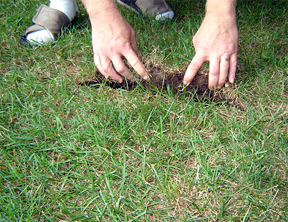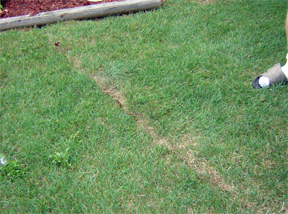Home lawn questions answered
Home lawn questions and answers
Editor’s note: This article is from the archives of the MSU Crop Advisory Team Alerts. Check the label of any pesticide referenced to ensure your use is included.
Question 1: Lawn split
Reader: Here are the pictures of my lawn showing the split in the grass. It is quite deep and on an angle and as you can see the grass can be peeled right back. I have never seen anything like this. Hopefully, you could have someone look at these that may have some ideas about this.
Dave’s answer: It looks like your lawn WAS cut by a knife. I am pretty sure the lawn was sliced by a slit-making machine to insert a cable. The slit runs straight across the lawn to the back of the house where I am betting there is a cable line that enters the house. In dry, hot weather slicing the turf can cause the turf to die along the edge of the cut. If it wasn’t for the knife-like cut in the turf, the line of dead turf looks somewhat like damage from a mole tunnel, an oil leak from a riding mower, or perhaps a sprayer leak when you were spraying Round-Up. But the pattern is not right for those other causes, and besides we have the smoking gun, or smoking “knife,” anyways.


Question 2: Emerald ash borer recommendations and grub control
Reader: At one time the maximum size recommended for home owner application of Bayer Tree and Shrub (Imidacloprid) for emerald ash borer was six inches in diameter. I'm pretty sure that size was increased but don't recall how much. Today, for curiosity I had one of our employees call the Bayer Consumer Help Line, and they did not give a size limitation. Basically they said "just use the recommended amount for the size tree you have."
Dave’s answer: For the Bayer Advanced product at the label rate I suggest a 12-inch dbh maximum. For over 12 inch dbh trees, you would need twice as much, and that is not on the current label. It will be on the label however, for the new homeowner product in 2011. Meanwhile, you could apply the Bayer Advanced product this fall and again next spring, and still be making applications only once per calendar year. Merit 75 and Xytect labels already say to make two applications for trees greater than 15 inches dbh.
Reader: I also had the employee ask about grub control. The Bayer rep said that the "All Seasons Grub Control" was always best to use. It has been my understanding that as we get to the end of August, we are running out the window for optimal control. When would you say we should be switching to Dylox? We are running into increased grub activity this year. I am kind of surprised since we have had a moist and cool July and even though August temperatures are more typical, most of non-irrigated lawns look pretty green.
Dave’s answer: Right! By September 1 this year (usually it is August 15), switch to using Sevin or Dylox for grub control. Homeowner products containing imidacloprid give a higher level of grub control, but in an average year (weather-wise) they should be applied before August 15 in Michigan.
Reader: We looked at some Potentilla that one our customers bought early this spring and it had dried up. After pulling the plant up, we saw that the majority of the roots had been eaten off. Which one of the grubs would that have been? Or was it a root weevil?
Dave’s answer: Most likely it was European chafer or June beetle grubs, but I would have to see the grubs to be sure.
Dr. Smitley's work is funded in part by MSU's AgBioResearch.



 Print
Print Email
Email
